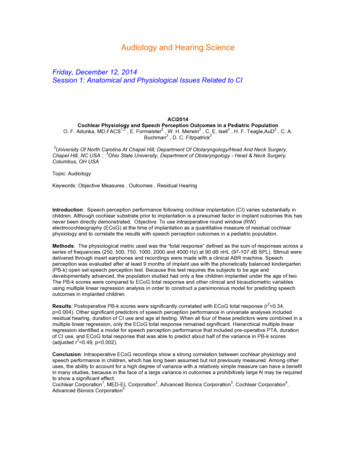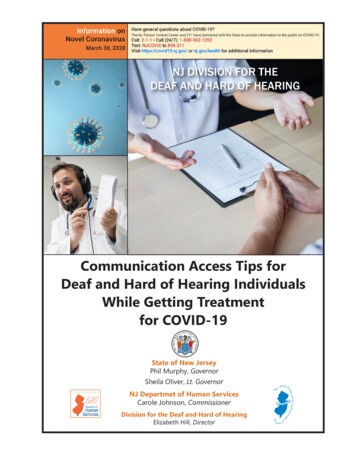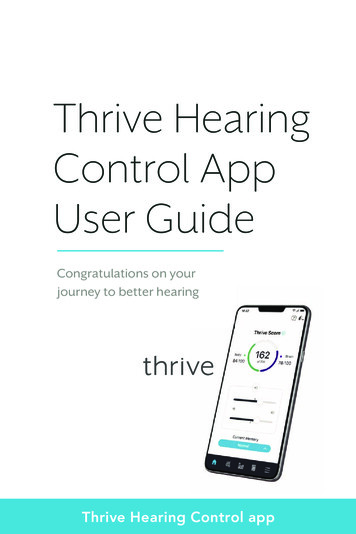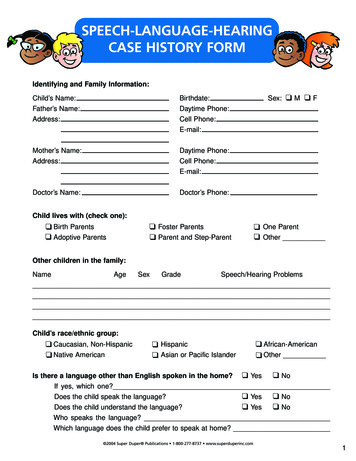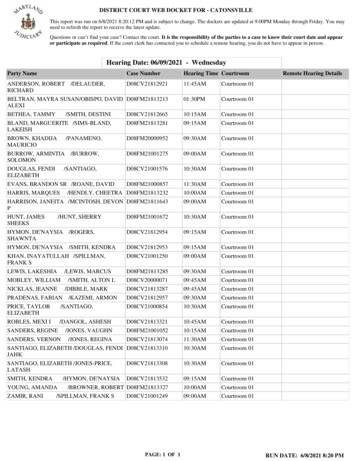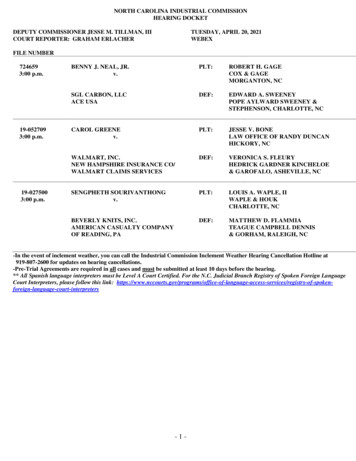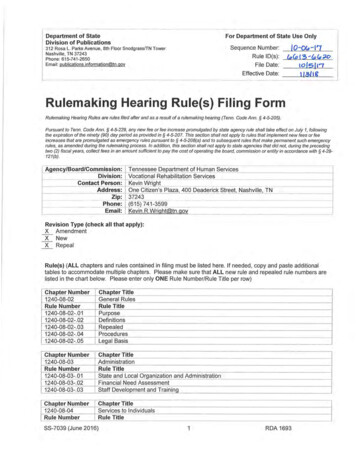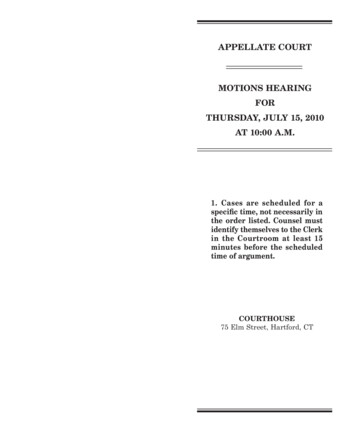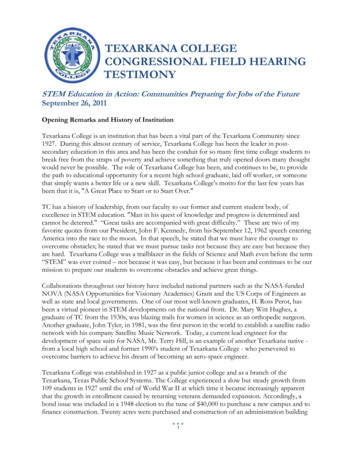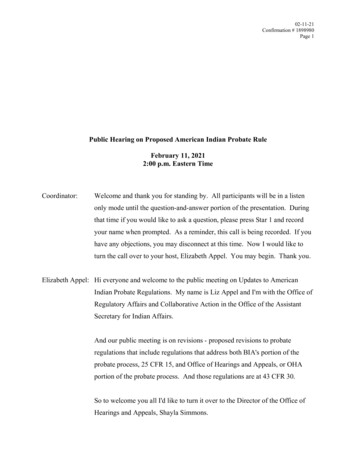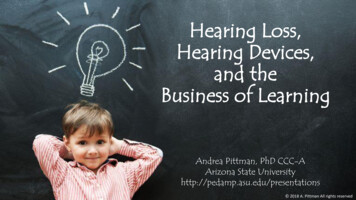
Transcription
Hearing Loss,Hearing Devices,and theBusiness of LearningAndrea Pittman, PhD CCC-AArizona State Universityhttp://pedamp.asu.edu/presentations 2018 A. Pittman All rights reserved
DisclosuresThis work was supportedby grants from:Research Assistants (The Pitt Crew):Elizabeth StewartLauren MeadowsNicole MarzanBeatriz LazaroElizabeth RainyAmy Stahl(and many more)Ian OdgearAmanda WillmanMadalyn RashBrittany SchuettAshley WrightJacelyn OlsonAnd collaborators:Hearing IndustryResearch ConsortiumArizona CommunityFoundationRachel Krupa – Mesa Public Schools, AZ, USJudy Attaway – Casa Colina Hospital, CA, USDan Duran – Valley Children’s Hospital, CA, USTove Rosenbom – Oticon Medical, DKRavi Sockalingam – Oticon Medical, USLiz Presson – Oticon Medical, US 2018 A. Pittman All rights reserved
Kids with Hearing Loss 2018 A. Pittman All rights reserved
Hearing and AgeHEARING LOSS(degree)ProfoundMild0510AGE (years)1518 2018 A. Pittman All rights reserved
Age 2018 A. Pittman All rights reserved
Degree of Hearing Loss227 Children (6 years old)Sensorineural hearing loss10%ProfoundHEARING LOSS (degree)21%SevereMild(15-40 dB HL)39%MildModerate(41-60 dB HL)Severe(61-80 dB HL)30%ModerateProfound( 80 dB HL)AGE (years)Pittman & Stelmachowicz (2003) Hearing loss in children and adults: Audiometric configuration, asymmetry, and progression. Ear & Hearing, 24(3), 198-205. 2018 A. Pittman All rights reserved
Degree of Hearing LossHEARING LOSS (degree)317 children (6 months to 7 years of age)Better-ear PTASevere 3%ModerateSevere20%Slight 5%Mild32%Moderate40%AGE (years)Tomblin et al. (2015) Outcomes of Children with Hearing Loss: Data Collection and Methods, Ear & Hearing, 36, Sup 1, 14s-23s. 2018 A. Pittman All rights reserved
Degree of Hearing Loss134 children (0 to 6 years)Better ear PTAHearing loss requiring amplificationProfound9%HEARING LOSS (degree)Severe16%Mild43%Moderate32%AGE (years)Russ et al (2003) Epidemiology of congenital hearing loss in Victoria, Australia, Int J Audiology, 42, 385-390. 2018 A. Pittman All rights reserved
Configuration of LossAdultsChildrenFrequency (Hz)Hearing Level (dB HL)250Frequency (Hz)500 1000 2000 4000 00 1000 2000 4000 8000Pittman & Stelmachowicz (2003) Hearing loss in children and adults: Audiometric configuration, asymmetry, and progression. Ear & Hearing, 24(3), 198-205. 2018 A. Pittman All rights reserved
Hearing and AgeHEARING LOSS(degree)ProfoundMild0510AGE (years)1518 2018 A. Pittman All rights reserved
The Business of Learning 2018 A. Pittman All rights reserved
Vocabulary Development inEarly ChildhoodChildrenHEARING LOSS (degree)317 HI Children117 NH ChildrenAGE (years)Tomblin et al. (2015) Ear & Hearing, Language Outcomes in Young Children with Mild to Severe Hearing Loss, 36, Supp 1, 76s–91s 2018 A. Pittman All rights reserved
Vocabulary DevelopmentSecretly Awesome2099 HI Children116 NH ChildrenNHHEARING LOSS (degree)PPVT Vocabulary Age (years)25HL15105AGE (years)04Pittman & Latto (1998-2008)5678910 11 12Chronological Age (years)131415 2018 A. Pittman All rights reserved
Vocabulary DevelopmentSecretly AwesomeHEARING LOSS (degree)40 HA Children47 CI ChildrenAGE (years)Blamey et al (2001) Relationships among speech perception, production, language, hearing loss, and age in children with impaired hearing, JSLRH, 44, 264-285. 2018 A. Pittman All rights reserved
Vocabulary Knowledgeand Hearing LossPPVT Standard Score12010010680826040200NHHLSarchet et al (2014), Vocabulary Knowledge of Deaf and Hearing Postsecondary Students, J Postsecond Educ Disabil, 27(2), 161-178.OverestimateKnowledgeof VocabularyPPVT Overestimate (120 items)ActualVocabularyKnowledgeCollege Students97 Normal Hearing93 Mild to Profound Hearing Loss3025201515.51057.70NHHL 2018 A. Pittman All rights reserved
Vocabulary Knowledgeand Hearing y)12010050401048078608440History ScorePPVT Standard ScoreCollege Students89 Normal Hearing25 w/Cochlear Implants 3.5 yrs68 w/Cochlear Implants 3.5 yrs3020201000NHCICI 3.5yrs 3.5yrs2715NH14CICI 3.5yrs 3.5yrsCovertino et al (2014) Word and World Knowledge Among Deaf Learners With and Without Cochlear Implants, J Deaf Studies and Deaf Ed, 19;4 2018 A. Pittman All rights reserved
How many wordsdo we need to know?The average college student knows between 15,000 and 200,000 words(D’Anna et al 1991).Oxford Dictionary of American English430,000 total entries1000 new entries each year- new words- new definitions to existing wordsD’Anna, C.A., E. B. Zechmeister, and J.W. Hall (1991) Toward a meaningful definition of vocabulary size. Journal of Reading Behavior 23.1: 109–22. 2018 A. Pittman All rights reserved
What does this mean?Children have a lot of word-learning to do.50,000 wordslearned over 18 years (3 to 22 years) 7 new words everydayAdults need to update their vocabularies too.1,000 words per year 3 new words every day 2018 A. Pittman All rights reserved
Michel et al, (2011) Science, 331, 176-18252% of the words we read inbooks are lexical “dark matter”;they are undocumented instandard dictionaries.(A) The size of the English lexicon over time. Tick marks showthe number of single words in three dictionaries. p. 177Michel et al, 2011 Quantitative Analysis of Culture Using Millions of Digitized Books, Science, 331, 176-182 2018 A. Pittman All rights reserved
What about adults? 2018 A. Pittman All rights reserved
Do adults update their vocabularies?On standardized vocabulary tests, older adults outperformed youngeradults (Verhaeghen, 2003).Better vocabulary scores with increasing age may be due to a cohorteffect that favors the earlier born (Flynn effect).-302019501960197019801990Stahl, Marzan, and Pittman (in process)Verhaeghen (2003) Aging and Vocabulary Scores: A Meta-Analysis. Psychology and Aging, 18(2), 332–339.Flynn (1987) Massive IQ gains in 14 nations: What IQ tests really measure. Psychological Bulletin, 101, 171–191.20 yrs70 yrs2000VocabTest2010 2018 A. Pittman All rights reserved
Updates to Adult VocabularyDepthBreadthHenriksen’s (1999) lexical knowledge model:1. Size - how many words are known2. Depth - how well the words are known3. Mastery - comprehension andproduction of the wordsAshley Wagner, EditorOxford Dictionary of American EnglishStahl, Marzan, and Pittman (in process) 2018 A. Pittman All rights reserved
Vocabulary Then and Now Test(VTNT)Word TypeLongstanding wordswith establisheddefinitions#Example15 Aghast: Filled with horror or shock15Ship: The desire of a fan for twofictional characters to be in a romanticrelationshipNew words15Senioritis: Affliction of students in theirfinal year of high school or college,characterized by a decline in motivationor performance.Nonsense words5Longstanding wordswith new definitionsStahl, Marzan, and Pittman (in process)Desill 2018 A. Pittman All rights reserved
Updates to Adult Vocabulary1. Affirmativea) To have an effect on; to make a difference tob) Agreeing with a statement or to a requestc) Making an assertiond) To move someone emotionallye) I don’t knowStahl, Marzan, and Pittman (in process) 2018 A. Pittman All rights reserved
Updates to Adult Vocabulary1. Affirmativea) To have an effect on; to make a difference tob) Agreeing with a statement or to a requestc) Making an assertiond) To move someone emotionallye) I don’t knowStahl, Marzan, and Pittman (in process) 2018 A. Pittman All rights reserved
Updates to Adult Vocabulary2. Voluntourisma) To freely offer services in support of a cause.b) The commercial organization of vacations and visits toplaces of interest.c) To enter into the military service voluntarily.d) A form of tourism in which travelers participate involuntary humanitarian work.e) I don’t know.Stahl, Marzan, and Pittman (in process) 2018 A. Pittman All rights reserved
Updates to Adult Vocabulary2. Voluntourisma) To freely offer services in support of a cause.b) The commercial organization of vacations and visits toplaces of interest.c) To enter into the military service voluntarily.d) A form of tourism in which travelers participate involuntary humanitarian work.e) I don’t know.Stahl, Marzan, and Pittman (in process) 2018 A. Pittman All rights reserved
Vocabulary Then and Now Test(VTNT)1.0Hearing StatusUnknownn20-396840-596360-7413Total 144PerformanceAge (yrs)0.820-39 yrs40-59 yrs60-74 yrs0.60.40.20.0OverallStahl (2016) Updates to adults vocabulary. ARESOld DefinitionsNew Definitions 2018 A. Pittman All rights reserved
Vocabulary Then and Now Test(VTNT)Adults 20-92 yearsPTA (dB HL)n0-204921-401841-601581-1008Total94Performance (proportion correct)1.00.80.60.40.20.0Old DefinitionsNew Definitions0-20Marzan & Hutton (2018)21-4041-6081-100PTA Hearing Level (dB HL) 2018 A. Pittman All rights reserved
When do adults and childrenlearn new words?ChildrenSchoolHomeFriendsActivitiesSocial MediaAdultsSecond language learningMedical terminologyMeeting new peopleTraveling to new placesOn the job trainingProfessional conferences 2018 A. Pittman All rights reserved
Hearing Loss and Learning 2018 A. Pittman All rights reserved
Auditory Learning TasksWord RecognitionHow well they can recognize words they already knowLexical Decision TaskHow well they can recognize words they don’t knowNon-Word DetectionHow well they can detect words they don’t know in contextRapid Word LearningHow well they can learn new words 2018 A. Pittman All rights reserved
Overall PurposeTo determine if differences in device output (like bandwidth) improveperformance for auditory tasks important to learning newinformation. 2018 A. Pittman All rights reserved
Air-Conduction Devices4 kHz120Level (dB SPL)100FF Thresholds10 kHz4 kHzOticonminiAlta RITE10 kHzsothnuddoztul8060fosnush40200250 400 630 1000 1600 2500 4000 6300Frequency (Hz)GroupAge (yrs)nChildren w/HL8-1221Adults w/HL52-7817stomunhomtul 2018 A. Pittman All rights reserved
Bone-Conduction DevicesConventional Skin-DrivePercutaneous Direct-DriveParticipants17 children10 boys, 7 girls7 – 15 years14 bilateral conductive1 unilateral conductive2 unilateral profoundReinfeldt et al., (2015) New Developments in bone-conduction hearing implants: A review, Medical Devices (Auckl), 8, 79-93.Sockalingam, R., and Pfeiffer, J. (2013, February). Audiological considerations of the Ponto Bone-anchored Hearing System before and after surgery. AudiologyOnline, Article #11654. Retrievedfrom http://www.audiologyonline.com. 2018 A. Pittman All rights reserved
MethodFitting & TestingDirect DriveSkin Drive 2018 A. Pittman All rights reserved
Method0.25VerificationFrequency (kHz)0.51248Device OutputForce (µN)1008060Skin DriveDirect Drive4015Difference (Skin-Direct)10105010.2514450.5124Frequency (kHz)8 2018 A. Pittman All rights reserved
Method-208Aided Sound-Field Thresholds0Level (dB HL)Verification0.25Frequency (kHz)0.5124204060Skin DriveDirect e (Skin-Direct)0.250.5124Frequency (kHz)8 2018 A. Pittman All rights reserved
MethodTest Parameters53 dB SPL in quiet0o azimuthData collectionComputer interfaceDigital audio recordings 2018 A. Pittman All rights reserved
Word RecognitionGroupAge (yrs)nChildren w/HL8-1221Adults w/HL52-7817Wideband Amp (% owband Amp (% correct)Pittman et al (2017) Detecting and Learning New Words: The Impact of Advancing Age and Hearing Loss, AJA, 26, 318-327. 2018 A. Pittman All rights reserved
Word Recognition0.25-20Frequency (kHz)0.5124100Aided Sound-Field ThresholdsDirect Drive (% Correct)Level (dB HL)0204060Skin DriveDirect erence (Skin-Direct)0.250.5124Frequency (kHz)Unilateral (Conductive, SSD)Bilateral (Conductive)8Age 0406080100Skin Drive (% Correct)8 2018 A. Pittman All rights reserved
Auditory Lexical t RealGlatRealRepeatCategorizeGladNot RealSwimRealGladRealSwimNot RealGratNot RealSrimRealGratRealSrimNot RealWhimRealWhimNot RealPittman and Rash (2015) Auditory Lexical Decision and Repetition in Children: Effects of Acoustic and Lexical Constraints, E&H, 37, e119-128.Pittman et al (2017) Word Recognition and Learning: Effects of Hearing Loss and Amplification Feature, Trends in Hearing, 21, 1-13. 2018 A. Pittman All rights reserved
Auditory Lexical Decision kinvosamaunellruppimPittman & Rash (2016). Auditory Lexical Decision and Repetition in Children: Effects of Acoustic and Lexical Constraints. Ear and Hearing 2018 A. Pittman All rights reserved
GroupAge (yrs)nChildren w/HL8-1221Adults w/HL52-7817Wideband Amplification (% correct)Auditory Lexical owband Amplification (% correct)Pittman et al (2017) Word Recognition and Learning: Effects of Hearing Loss and Amplification Feature, Trends in Hearing, 21, 1-13. 2018 A. Pittman All rights reserved
Auditory Lexical Decision0.25-20Frequency (kHz)0.51248100Aided Sound-Field Thresholds80Direct Drive (% correct)Level (dB HL)0204060Skin DriveDirect Drive801000-5-10-15-20-25Unilateral (Conductive, SSD)Bilateral (Conductive)-24020-6-11-14Group-16-20Difference (Skin-Direct)0.25600.5124Frequency (kHz)Age (yrs)nBilateral7-1514Unilateral7-1530020406080Skin Drive (% Correct)1008 2018 A. Pittman All rights reserved
Non-Word Detection 2.0# ofnonsensewordsExample phrase0Clocks tick on time.1Birds rike long worms.2Dats catch slow bice.3-4-1234NextPittman & Daliri (in press) Vocal biomarkers of mild-to-moderate hearing loss in children and adults: Voiceless sibilants, JSLHR 2018 A. Pittman All rights reserved
Non-Word Detection 2.0Frequency (kHz)1248-2020Age (yrs)nChildren w/HL8-1722Adults w/HL55-802340Frequency (kHz)600.25 0.5801001201-20Aided SFUnaided SF0Hearing Level (dB HL)Hearing Level (dB HL)0Group204080120484.03.02.01.00.06010025.0Target Sensitivity (d’)0.25 0.5-1.0Aided SFUnaided SF-1.00.0 1.0 2.0 3.0 4.0Target - 5 dB Sensitivity (d’)Pittman & Daliri (in press) Vocal biomarkers of mild-to-moderate hearing loss in children and adults: Voiceless sibilants, JSLHR5.0 2018 A. Pittman All rights reserved
Non-Word Detection 2.0-20Frequency (kHz)0.51245.08Sensitivity via Direct Drive (d')0.25Aided Sound-Field ThresholdsLevel (dB HL)0204060Skin DriveDirect erence (Skin-Direct)0.250.5124Frequency (kHz)Age (yrs)nBilateral7-1514Unilateral7-153Unilateral (Conductive, SSD)Bilateral 5.0Sensitivity via Skin Drive (d')8 2018 A. Pittman All rights reserved
Rapid Word Learning1008070605040302010𝑃𝑐 1 0.80𝑒 𝑛/𝑐Learning Speed:3 1 trial (perfect learning)2 10 trials1 100 trials0 1000 trials (no MANCE (% Correct)90TRIALS 2018 A. Pittman All rights reserved
Rapid Word LearningGroupAge (yrs)nChildren w/HL8-1221Adults w/HL52-7817Learning Speed (log 1000/n)3Pittman et al (2017) Detecting and Learning New Words: The Impact of Advancing Age and Hearing Loss, AJA, 26, 318-327.ChildrenAdults2121813633980NHHLUnaided 2018 A. Pittman All rights reserved
Rapid Word LearningGroupAge (yrs)nChildren w/HL8-1221Adults w/HL52-7817Learning Speed (log 1000/n)3Pittman et al (2017) Detecting and Learning New Words: The Impact of Advancing Age and Hearing Loss, AJA, 26, 318-327.ChildrenAdults21218164710NHHLHF Amp 2018 A. Pittman All rights reserved
GroupAge (yrs)nChildren w/HL8-1221Adults w/HL52-7817High-Freq Amp (log 1000/n)Rapid Word Learning321ChildrenAdults0012Standard Amp (log 1000/n)Pittman et al (2017) Detecting and Learning New Words: The Impact of Advancing Age and Hearing Loss, AJA, 26, 318-327.3 2018 A. Pittman All rights reserved
Rapid Word Learning0.25-20Frequency (kHz)0.51248Unilateral (Conductive, SSD)Bilateral (Conductive)3Aided Sound-Field ThresholdsDirect Drive (log 1000/n)Level (dB HL)020240601000-5-10-15-20-251Skin DriveDirect Drive80-2-6-11-14Group-16-20Difference (Skin-Direct)0.250.5124Frequency (kHz)Age (yrs)nBilateral7-1514Unilateral7-1530012Skin Drive (log 1000/n)38 2018 A. Pittman All rights reserved
GroupAge (yrs)nChildren w/HL8-1221Adults w/HL52-7817Rapid Word Learning (Speed)Speech Perception vs. Word Learning3AdultsChildren2100Pittman et al (2017) Detecting and Learning New Words: The Impact of Advancing Age and Hearing Loss, AJA, 26, 318-327.20406080100Word Recognition (% correct) 2018 A. Pittman All rights reserved
What can we conclude?Detecting and learning new words is is essential for keeping vocabulary current independent of the type of amplification device determined by the quality of the auditory input. 2018 A. Pittman All rights reserved
Thanks forlearninghttp://pedamp.asu.edu/presentations 2018 A. Pittman All rights reserved
(A) The size of the English lexicon over time. Tick marks show the number of single words in three dictionaries. p. 177 Michel et al,
